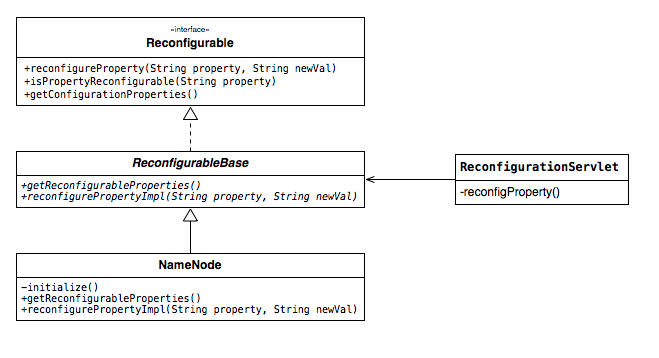HADOOP动态加载配置
##简介 Hadoop集群运行过程中有时会需要对配置进行修改,而通常需要重启才能生效,如该HDFS Namenode的一个配置,需要重启NN才能生效。而对于规模较大的系统,重启的成本较高。HADOOP-7001引入了一个reconfigurable机制。简述如下:

HADOOP-7001提供了一个Reconfigure接口用于定义可动态配置的的行为。并提供了一个ReconfigurableBase抽象的基类实现。该基类有两个抽象方法,所有想要实现动态配置的节点,都需要实现这两个方法:
//某个可以动态配置的属性变化时需要进行的处理
protected abstract void reconfigurePropertyImpl(String property, String newVal)
throws ReconfigurationException;
//定义该节点上所有可以进行动态配置的属性集合
public abstract Collection<String> getReconfigurableProperties();
为了便于完成配置项变更,HADOOP-7001还提供了一个ReconfigurationServlet工具便于从web端变更配置。使用时只需要将该servelt加入到相应节点的httpserver中,并在context中加入conf.servlet.reconfigurable.$P的参数,值为对应的Reconfigurable实现(一般为节点自身实现),其中$P表示的是ReconfigurationServlet在httpServer中对应的path。
##NameNode中的使用
HDFS-1477中提供了NameNode Reconfigurable的实现。概要分析如下:
1. 扩展ReconfigurableBase
首先需要扩展Reconfigurable来使NameNode支持动态配置
public class NameNode extends ReconfigurableBase implements ClientProtocol,
DatanodeProtocol,NamenodeProtocol, FSConstants {
//。。。。
//此处省略N多无关代码
//
//实现当发生配置变更时Namenode的具体处理行为
@Override
public void reconfigurePropertyImpl(String property, String newVal)
throws ReconfigurationException {
// just pass everything to the namesystem
if (namesystem.isPropertyReconfigurable(property)) {
namesystem.reconfigureProperty(property, newVal);
} else if ("fs.trash.interval".equals(property)) {
try {
if (newVal == null) {
// set to default
trash.setDeleteInterval(60L * Trash.MSECS_PER_MINUTE);
} else {
trash.setDeleteInterval((long)(
Float.valueOf(newVal) * Trash.MSECS_PER_MINUTE));
}
LOG.info("RECONFIGURE* changed trash deletion interval to " +
newVal);
} catch (NumberFormatException e) {
throw new ReconfigurationException(property, newVal,
getConf().get(property));
}
} else {
throw new ReconfigurationException(property, newVal,
getConf().get(property));
}
}
//设置NameNode上允许动态配置的属性值
@Override
public List<String> getReconfigurableProperties() {
// only allow reconfiguration of namesystem's reconfigurable properties
List<String> properties = namesystem.getReconfigurableProperties();
properties.add("fs.trash.interval");
return properties;
}
###2. 在httpserver中配置ReconfigurationServlet 为了便于配置,需要在httpserver中添加ReconfigurationServlet,具体代码如下
private void startHttpServer(Configuration conf) throws IOException {
//省略无关代码
//设置context属性
httpServer.setAttribute(ReconfigurationServlet.
CONF_SERVLET_RECONFIGURABLE_PREFIX +
CONF_SERVLET_PATH, NameNode.this);
//添加servelt, path为nnconfchange
httpServer.addServlet("nnconfchange", CONF_SERVLET_PATH,
ReconfigurationServlet.class);
this.httpServer.start();
// The web-server port can be ephemeral... ensure we have the correct info
infoPort = this.httpServer.getPort();
this.httpAddress = new InetSocketAddress(infoHost, infoPort);
conf.set("dfs.http.address", infoHost + ":" + infoPort);
LOG.info("Web-server up at: " + infoHost + ":" + infoPort);
}
###3.具体使用 登录到NN,修改配置文件,通过web访问 http://hdfsnn:port/nnconfchange来查看配置项,点击apply可以是新的配置项生效,如果配置项变更出错会返回500.
blog comments powered by Disqus